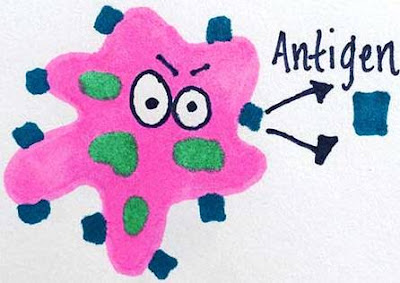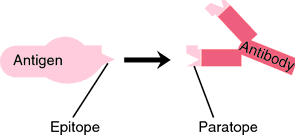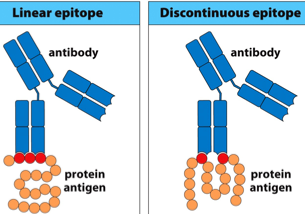What is an Antigen
Immune System | Biotechnology
After learning about the various basic conceptual of immune system, today
we will go through into the deep learning about an Antigen.
An introductory statement for an Antigen has been pen down in my post ‘Immune System Basic Concepts’. I would
like to advise all of you to please go through the above post, so that you can
at least get an idea about the word Antigen.
Here, we all will be going through the various
aspects of an Antigen, which will
cover the following queries.
·
What is an Antigen?
·
What are Immunogenicity and
Antigenecity and how they are different from each other?
·
What are Epitopes?
·
What are Haptens and how they are
related to Antigenecity?
·
What are Pattern Recognition
Receptors?
Let’s
begin our learning process step by step…
·
What is an Antigen?
An Antigen is
simply a protein molecule expressed
by a bacteria or virus, which is recognized as an invader or a foreign
body by the immune system, which in turn stimulates the production of antibody to specifically combine with them.
 |
| fig. Antigen |
Basically, Antigen
is present on the cell surface of bacteria and viruses.
Antigen
comprises of bacteria, cells of
transplanted organs, pollen particles of plants and toxins.
·
What are Immunogenicity and
Antigenecity and how they are different from each other?
Immunogenicity
is the term used when a foreign molecule is capable enough to generate a
humoral immune response leading to the production of antibodies.
It can be better explained with an example: If B cells get activated , it will differentiate into plasma B cells,
resulting in secretion of antibodies.
Antigenicity
or Reactogencity is the process
which defines the ability of combining with the final products of humoral or
cell mediated immune response.
It does not
activate the immune response; rather it combines with the final products of
the immune response.
For clear understanding about antigenicity, we will
cite an example: On activation of B cells, it secretes
antibodies and antigen having the property of antigenecity will combine with
the respective antibodies.
Difference
between Immunogenicity and Antigenecity :
A single statement is sufficient to explain or clear
the confusion between Immunogenecity
and Antigenecity.
It says “All molecules having property of
immunogenicity , also possess the property of antigenecity, but the reverse is
not true i.e. molecules having antigenecity does not necessarily have the
property of immunogenicity ”.
·
What are Epitopes?
Epitopes
are the parts or portions or regions of
antigen which are responsible for the specific character of antigen during
antigen- antibody (Ag-Ab) reaction.
Epitopes
combine with the complementary antigen binding site of antibody i.e. A single
individual antibody recognize a single epitope.
Polyclonal
antibodies are an exception to the above mentioned statement
about epitopes, as these antibodies
recognize many different epitopes.
 |
| fig. Epitope |
Epitopes
are divided into two types :
i.
Linear
Epitopes
ii.
Discontinuous
Epitopes
i.
Linear
Epitopes:
Linear Epitopes constitute the residues of amino
acids which are adjacent in the
polypeptide chain.
ii.
Discontinuous
Epitopes :
Discontinuous Epitopes are created from amino acid
residues which are located in different parts
of the polypeptide chain.
Linear Epitopes and Discontinuous Epitopes can be diagrammatically represented as shown in the below figure.
 |
| fig. Types of Epitopes |
Epitopes
are distinguished into three types :
a.
Free
soluble molecule
b.
Surface
bound molecule
c.
Degraded
fragments
B
cell receptors bind with any of the above mentioned
category of epitopes i.e. they can be either free soluble molecule or
surface bound molecule and might be degraded fragments.
On the other hand, T cell receptors bind only to the epitopes which are intact with
the host cell surface molecule.
·
What are Haptens and how they are
related to Antigenecity :
Haptens
or Incomplete Antigens or Artificial monovalent epitope are minute, non biologic molecules like peptides
or nucleotides which provoke an immune response, only when attached to a large
carrier.
 |
| fig. Haptens |
When haptens
link up with body proteins, the body’s adaptive immune response recognize them
as foreign particle and mount an attack.
Haptens
are used in Antibiotics and Anesthetics designing.
They are present in poison ivy, some detergents and cosmetics.
Haptens
are of two types :
i.
Complete
haptens
ii.
Incomplete
haptens
i.
Complete Haptens :
Complete Haptens when
combine with specific antibody forms precipitates.
ii.
Incomplete Haptens :
Incomplete Haptens on combining with
specific antibody, no precipitation is formed.
‘Haptens have the property of antigenecity
but not immunogenicity’. This statement can be well explained by
the famous Land Steiner’s Experiment.
i.
Hapten à
Injected in mice à No immune response
(2,4-
dinitrophenyl tyrosine)
ii.
Carrier (protein) à
Injected in mice à Positive immune response
iii.
Hapten- Carrier Conjugate à
Injected in mice à Anti hapten and anti
Carrier
antibodies
·
What
are Pattern Recognition Receptors?
They are the immune
system receptors that recognize the structural motifs of the pathogen.
Pattern
Recognition Receptors work in the following way:
a.
Firstly,
they eat the pathogens and break down their protein into smaller particles.
b.
These
protein fragments are transferred to their cell surface with the help of Major
Histocompatibility Complex (MHC) molecule.
c.
On
activation, they switch on the cell surface receptor, which in turn activates T
cells and B cells, further shaping up the immune response.
Examples
of most known Pattern Recognition
Receptors are:
Ø Mannose Binding Lectin (MBL)
Ø Macrophage Mannose Receptor
Ø Scavenger Receptors
Ø Toll like Receptors (TLR’s)
Ø RIG – I like Receptors (RLR’s)
Ø Nod like Receptors (NLR’s)
After going through the descriptive learning, now we
will move towards some memorizing points.
Points
to Remember :
ü An
antigen is a protein, considered as
foreign by the immune system and produce antibodies.
ü Immunogenicity
is ability to produce humoral immune response.
ü Antigenicity
is the process of combining with the final products of humoral or cell mediated
immune response.
ü Epitopes
are portions of antigen which combine with the binding site of antibody.
ü Haptens
are molecules which produce immune
response, when attached to a big carrier.
ü Pattern Recognition
Receptors are the receptors which recognize structural
design of pathogens.
I hope, all your queries must be resolved, after
discussing about “Antigen” .
For a proper command on the topic, I would like to
suggest all of you to please go through all my posts at my blog "Learn Biotechnology with DeepaliTalk".
Starting from the very beginning to this post, I
have discussed each and every topic in such a way that it becomes easier for
you to understand every topic step by step.
Before taking your leave, I would like to advise you
all on my professional expertise that “Keep calm and don’t panic”.
I know it seems to be quite complex for you to understand, but believe me all of this becomes very very easy, once we will start discussing each one of these topics separately. Have patience and don’t give up and just understand the
topics as they are without any stress and please remember “Don’t get confused with the
similar sound words”.
There
is lot more to share, Keep in touch and stay happy.
Happy
Antigen Learning!!!

